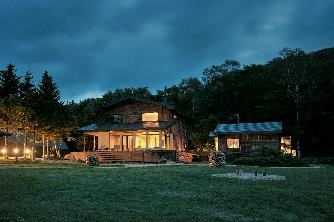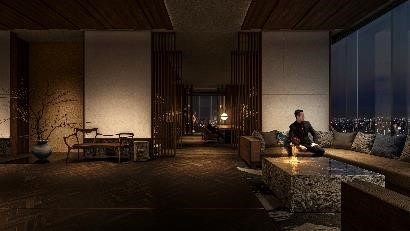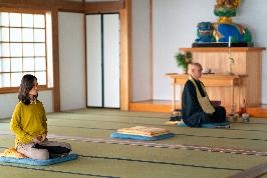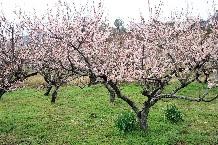
Japan National Tourism Organization (JNTO)
[JNTO] Exclusive Japan: Luxurious Destinations and Unique Experiences Awaiting Travelers
2024.02.01
Press release
PDF ver.

Seasoned travelers know that to truly know a place, you have to do more than simply visit a location, see a few sites and taste the local specialties. One also needs to understand the history of their destination, its secrets and all the little details that make that particular place genuinely unique. There are plenty of fascinating locales in Japan – a country blessed by natural landscapes stretching over 2,000 kilometers from north to south – and among them travelers can easily find vistas that stimulate the senses, the mind, and the heart, allowing you to find the real meaning of “luxury.” Here are three destinations where travelers can find such exclusive, unforgettable experiences.
Enjoy Unspoiled Wilderness, Where Humans and Wildlife Coexist in Perfect Harmony
The eastern part of Hokkaido, Japan’s northernmost island, is home to many national parks where visitors can immerse themselves in the wonders of nature. One prime example is the Kushiroshitsugen National Park, the largest wetland in Japan, which is a rich and invaluable habitat for many species of fauna, flora and birds, including the red-crowned crane. Before being designated as a national park, the Kushiro was the first area in the country to be recognized as a Ramsar Site (in 1980) under the Ramsar Convention on Wetlands of International Importance Especially as Waterfowl Habitat. Today, tourists can enjoy the wetland by canoeing along the Kushiro River, among other activities.
Another exciting destination is Shiretoko National Park, home to Japan’s largest population of brown bears and the Kamuy-wakka Hot Spring Falls, an all-natural hot-spring waterfall. Known for its majestic mountains, ice drifts and cliffs created through volcanic activity, Shiretoko’s name is said to come from the language of the Ainu, Hokkaido’s indigenous people and mean “end of the Earth” due to its location in the secluded northeastern part of the island. Shiretoko is also a highly-productive fishing region where the people use the bounty of the sea – including varieties of salmon, walleye pollock and kelp – in a sustainable way.
For a showcase of some of Japan’s most spectacular natural wonders, there are no better places than Hokkaido’s national parks. And to enjoy them to the fullest, there’s no better place than TAPKOP, a premium private-villa facility offering luxury within the heart of nature. Located in the Akan-Mashu National Park, TAPKOP is surrounded by primeval forests and is only a 20-minute drive from Lake Mashu, one of the world’s clearest lakes.
Discover the Poetry of Nature and Get the Royal Treatment in Nasu
Nasu Town is known today as a hot spring resort in Tochigi Prefecture (situated north of Tokyo) but it also offers other nature experiences like hiking or cycling tours where you can enjoy the local volcanic vistas and delicious food, as well as many other fun activities. Ride Experience is the most popular cycling tour operator in the area, offering various guided and self-guided tours, almost all of which are multi-day excursions with overnight stays rather than just one-day outings. Other excellent tourist spots in Tochigi Prefecture include the Shiobara hot springs easily accessible nature domain without having to journey into the middle of nowhere.
Also recommended is Nasunogahara, a plateau sandwiched between the Naka and Hoki Rivers and home to some of the 27 stations of the Oshu Kaido highway, which was the first link between Edo (modern-day Tokyo) and the Tohoku region (in northeastern Japan). The road was immortalized by Matsuo Basho, Japan’s most famous poet. Today, visitors to the area can walk in his footsteps, breathing in the history and while they visit ex-Ashino-shuku, one of the Oshu Kaido stations and attractions like the Yugyo Willow, once considered the gateway to Tohoku. Nasu also offers a lot in terms of education, being home to the Nasu History Museum designed by famed Japanese architect Kuma Kengo.
The historic Nasu Onsen, which opened in 630, is another can’t-miss area attraction. Enjoy a variety of indoor and open-air baths at the hot spring area like Shika-no-Yu (“deer spring”) said to derive its name from a legend of a wounded deer that became fully healed by the recuperative waters. Premier accommodations in Nasu include Hoshino Resorts RISONARE Nasu, a countryside agritourism destination combining natural landscapes with farming experiences, where guests can enjoy delicious dishes made from homegrown ingredients and/or witness firsthand how Japanese rice cultivation works. Another excellent option is Nasu Bettei Kai, which features nine suites and one private villa, all decorated in a traditional Japanese style. Offering private semi open-air baths filled with the clear hot spring waters sourced from Mt. Chausu, as well as seasonal cuisine featuring such premium ingredients as Nasu black beef, a stay at the facility is a trip into the heart of Nasu and luxury itself.
Explore Tottori and Shimane, the Birthplace of Japanese Mythology
Japanese people have long worshipped nature including Tottori Prefecture’s 1,709-meter-high Mt. Daisen, the highest mountain in the Chugoku Region once believed to be the home of Japanese deities and where Japan’s ancient beliefs still live. Known colloquially today as Japan’s “second Mt. Fuji,” the mountain is also home to the Daisen-ji Temple, built in 718. While in Tottori, be sure to also not miss the Mitokusan Sanbutsuji Temple, located on the 900-meter-high Mt. Mitoku; Legend says it was built into the sheer precipice by magic employed by the mystic En no Ozuno, founder of Shugendo, which incorporates elements of asceticism and shamanism.
When it comes to native Japanese beliefs, Izumo in Shimane Prefecture is foundational since it was the setting of many myths recorded in the Kojiki and Nihon Shoki, two of the oldest Japanese texts in existence. Izumo is home to the Izumo Taisha Grand Shrine, one of the most ancient and important Shinto shrines in Japan, and has long been associated with the afterlife in Shinto; according to Shinto belief, Izumo is where the religion’s multitudinous deities meet once a year. If you want to know how it feels like to step into the pages of Japan’s most sacred texts, you can visit such mystical Shimane locations as Bentenjima Shrine perched majestically on a large rock, or the Byobu Iwa (Folding Screen Rock) where the ownership of Japanese land was negotiated between powerful deities.
For lodging, you can choose to stay at the Minamikan at Matsue Shinjiko Onsen in Shimane. Founded in 1888, the inn has a long history of hosting literary figures such as Koizumi Yakumo, known more commonly as Lafcadio Hearn, the Irish-Greek writer and translator who had a fondness for Japanese mythology and introduced much of it to Western readers. Minamikan’s garden is famous for its tranquil beauty, offering magnificent views that have landed it in the top five of Sukiya Living Magazine: The Journal of Japanese Gardening's 2023 ranking of the best gardens in Japan.
Journey Beyond
Traveling to explore the hidden history and culture of regional destinations provides a chance to enjoy beautiful natural surroundings and simultaneously stimulate and relax the minds. This way, visitors can return home with a variety of precious memories worth more than any material goods. That is the true meaning of luxury. Fortunately, there are many places in Japan where you can do exactly that, and they’re all waiting for you to discover their unique charms.
Japan Tourism Topics
1. Discover a New Exciting Winter Hobby by Cycling the Slopes of Togari Onsen Snow Resort, Nagano
Bordering Nagano and Niigata Prefectures, Togari Onsen Snow Resort offers dynamic slopes where visitors can enjoy a variety of seasonal activities. Togari's snow-biking park allows visitors to ride fat bikes on the ski trails, providing a unique experience distinct from skiing or snowboarding. These “fat bikes” come with thick tires that can handle the snowy terrain. Open to anyone who can ride a bike, this adventure promises novelty and thrill in a pristine winter environment. After a day of biking, visitors can unwind in the relaxing hot springs, Akatsuki-no-Yu, just a one-minute walk from the Pegasus Slope. The slightly alkaline natural spring water in the indoor and open-air baths is said to be great for skin.
Bicycle Snow Ride
2. Experience the Luxury at The Royal Park Hotel Iconic Nagoya, Aichi, February 20
Set to open its doors on February 20th, 2024, in Nagoya's bustling district of Sakae, ‘The Royal Park Hotel Iconic Nagoya’ anticipates a grand debut ahead of the reopening of the ‘Chunichi Building’. With 246 rooms, this establishment aims to become a gateway to Chubu, introducing guests to the essence of the region with local crafts and designs, like tea utensils and traditionally plastered walls, that accentuate the charm of Chubu and its dramatic history formed by the three great masters of the Warring States period who were born in this area. Linked directly to the Nagoya Municipal Subway's Sakae Station, the hotel ensures seamless access from the underground shopping arcades of Sakae. Additionally, the “Ryurei Tea Room” invites guests to experience the amazing hospitality of a tea ceremony in a traditional space created by the gifted local craftsman from Gifu and be immersed in Chubu culture.
The Royal Park Hotel Iconic Nagoya
3. Mindfulness and Unique Cultural Experiences at Ichibata Yakushi, Shimane
A short trip from Osaka and atop a climb of 1,300 stone steps is, Ichibata Yakushi Temple. With over 1,000 years of history, they offer experiences such as Zazen meditation, Shakyo (sutra copying), and other Buddhist practices at a serene location that overlooks a mountainous landscape. A private Western-style cottage is available on its grounds for a memorable stay amongst nature. Indulge in an exclusive sauna experience, relish in the delicious and healthy Yakuzen (Japanese herbal medicinal cooking based on Chinese traditional medicine) breakfast, and marvel at the breathtaking night sky. Have an ethereal evening under the stars and watch the spectacular sunset views over Lake Shinji. Ichibata Yakushi highlights the serene beauty and harmony with the nature where you can refresh your body and mind in the great outdoors of Shimane Prefecture.
Ichibata Yakushi
4. An Early Glimpse of Spring Colors at the Plum Festival at Hirota Bairin Fureai Park, Hyogo
In the northern area of Minamiawaji City lies the enchanting Hirota Bairin Fureai Park, home to around 300 plum trees of thirteen varieties, including weeping plum trees. Ahead of Japan’s famous cherry blossoms, the vibrant plum blossoms reach their peak from mid-February to early March, heralding the arrival of spring in Japan. As the landscape blushes with delicate shades of pink and white, a sweet aroma fills the air, drawing in crowds to enjoy the Plum Festival held in the peak bloom period. The Hirota district has a long history of being a gorgeous plum blossom viewing spot, restored by passionate locals after the plum trees were tragically cut down due to food shortage during World War II. Complimented by the adjacent Omiya Temple, a revered site within the Awaji 88 Temple Pilgrimage, and the cherry blossoms continue to be a cherished area to enjoy the season’s spectacular scenery.
Hirota Bairin Fureai Park
5. Marvel at the Majesty of Japan’s Royalty in The Museum of the Imperial Collections, Sannomaru Shozokan, Tokyo
The Museum of the Imperial Collections, Sannomaru Shozokan, located within the Imperial Palace East Gardens, has reopened after a period of renovation, and houses a wide variety of art including paintings, calligraphy, and various other artifacts that were passed down in the Imperial Family. Mostly known for its collection of Asian works, especially from Japan, Sannomaru Shozokan also features pieces from other countries from various periods. Until June 23rd, the museum is holding a special exhibition, “The Aesthetics of the Imperial Court: Beauty Passed Down through the Ages” which presents a rich variety of artworks and objects on rotation, including items used by the modern Emperors and Empresses as well as classical masterpieces such as the folding screen Chinese Lions and Scenes from The Tale of Genji, and more. Discover the history and beauty of Japanese art through this limited event commemorating the opening of the Museum of the Imperial Collections, Sannomaru Shozokan. The advance online booking is required to enter the exhibit.
The Museum of the Imperial Collections, Sannomaru Shozokan
Notes:
・ Item 1, 3 is based on information from JNTO Partners.
・ The above details are correct as of the time of publication, and are subject to change.
If you’d like to download photos and videos of Japan's tourist attractions, please visit the Japan Online Media Center (JOMC)
For media inquiries, including requests to use photographs, please contact the JNTO Press at media_Inquiry@jnto.go.jp













